Detailed Management Accounting Report: Unit 5 for Prime Furniture
VerifiedAdded on 2022/11/28
|13
|2682
|300
Report
AI Summary
This report delves into the core concepts of management accounting, providing a detailed analysis of costing methods, budgetary control, and financial problem-solving strategies. It examines techniques such as absorption costing, marginal costing, and various planning tools used for budgetary control, including capital budgeting, cash budgets, operating budgets, and zero-based budgeting. The report also explores pricing strategies like penetration, skimming, and competitive pricing, as well as the importance of supply-demand considerations. Furthermore, it discusses strategic planning using SWOT analysis and how businesses, like Prime Furniture, can tackle financial challenges such as sudden expenses and late payments. The content is organized into tasks covering cost calculations, advantages and disadvantages of planning tools, and methods for addressing financial issues within an organization.
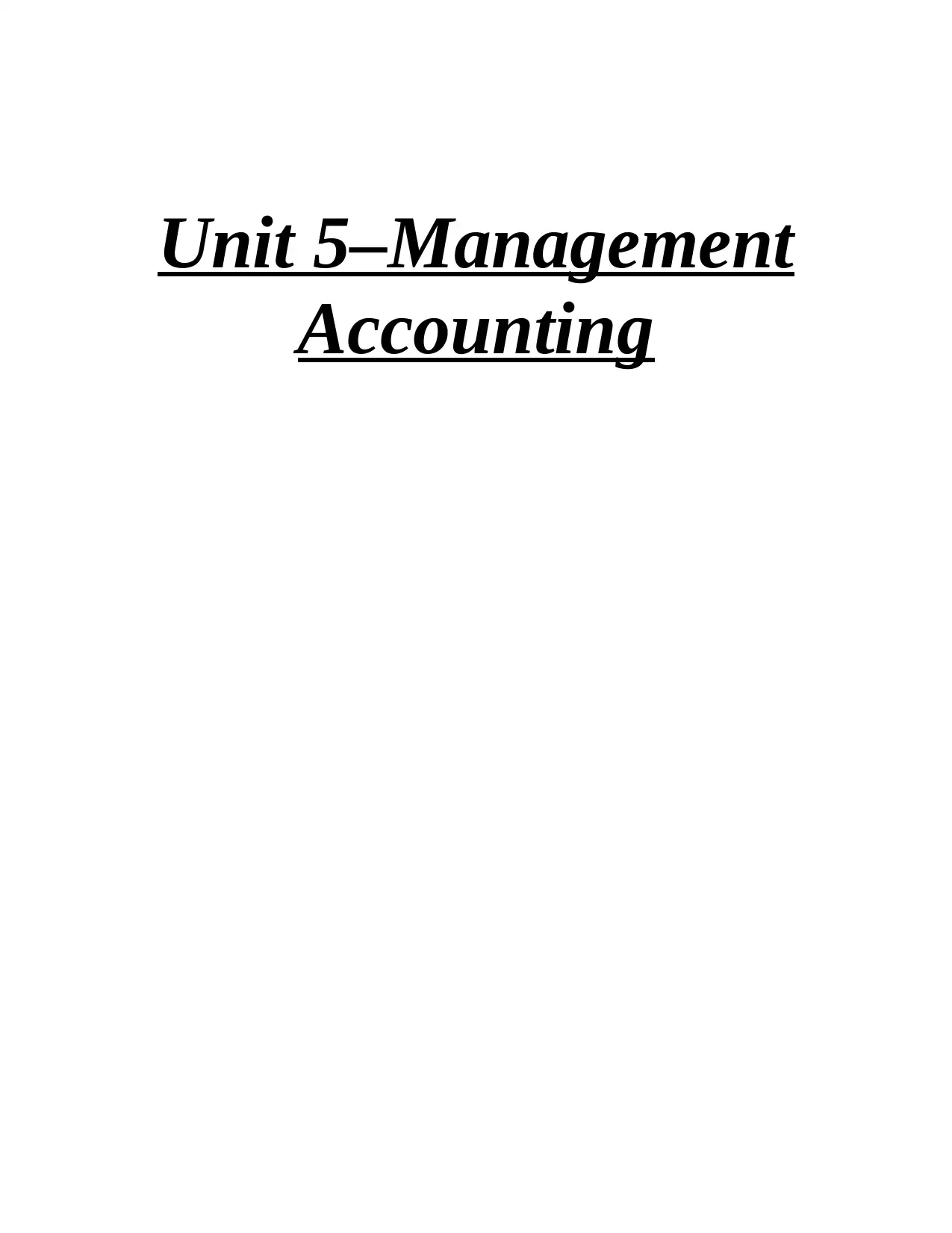
Unit 5–Management
Accounting
Accounting
Paraphrase This Document
Need a fresh take? Get an instant paraphrase of this document with our AI Paraphraser
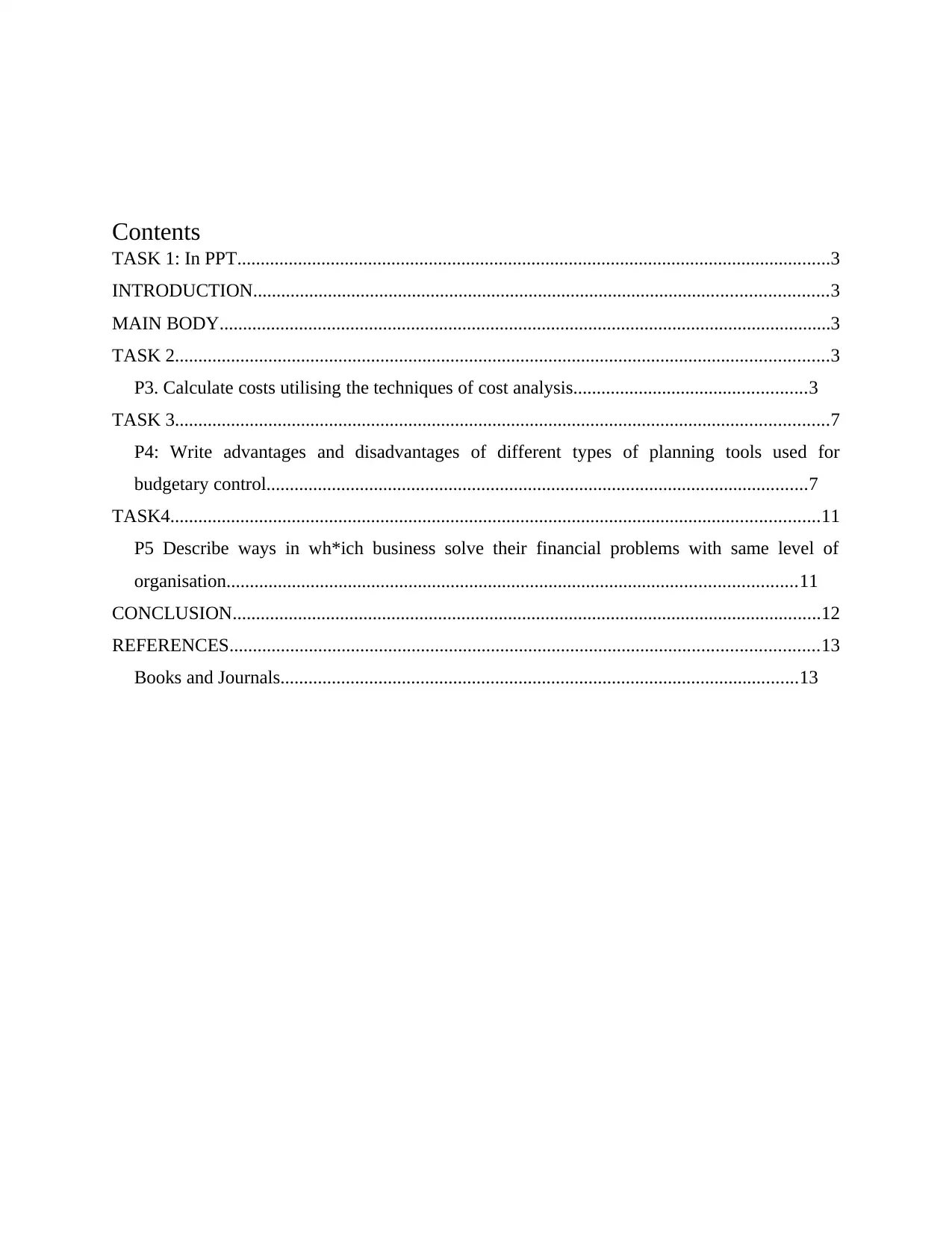
Contents
TASK 1: In PPT...............................................................................................................................3
INTRODUCTION...........................................................................................................................3
MAIN BODY...................................................................................................................................3
TASK 2............................................................................................................................................3
P3. Calculate costs utilising the techniques of cost analysis..................................................3
TASK 3............................................................................................................................................7
P4: Write advantages and disadvantages of different types of planning tools used for
budgetary control....................................................................................................................7
TASK4...........................................................................................................................................11
P5 Describe ways in wh*ich business solve their financial problems with same level of
organisation..........................................................................................................................11
CONCLUSION..............................................................................................................................12
REFERENCES..............................................................................................................................13
Books and Journals...............................................................................................................13
TASK 1: In PPT...............................................................................................................................3
INTRODUCTION...........................................................................................................................3
MAIN BODY...................................................................................................................................3
TASK 2............................................................................................................................................3
P3. Calculate costs utilising the techniques of cost analysis..................................................3
TASK 3............................................................................................................................................7
P4: Write advantages and disadvantages of different types of planning tools used for
budgetary control....................................................................................................................7
TASK4...........................................................................................................................................11
P5 Describe ways in wh*ich business solve their financial problems with same level of
organisation..........................................................................................................................11
CONCLUSION..............................................................................................................................12
REFERENCES..............................................................................................................................13
Books and Journals...............................................................................................................13
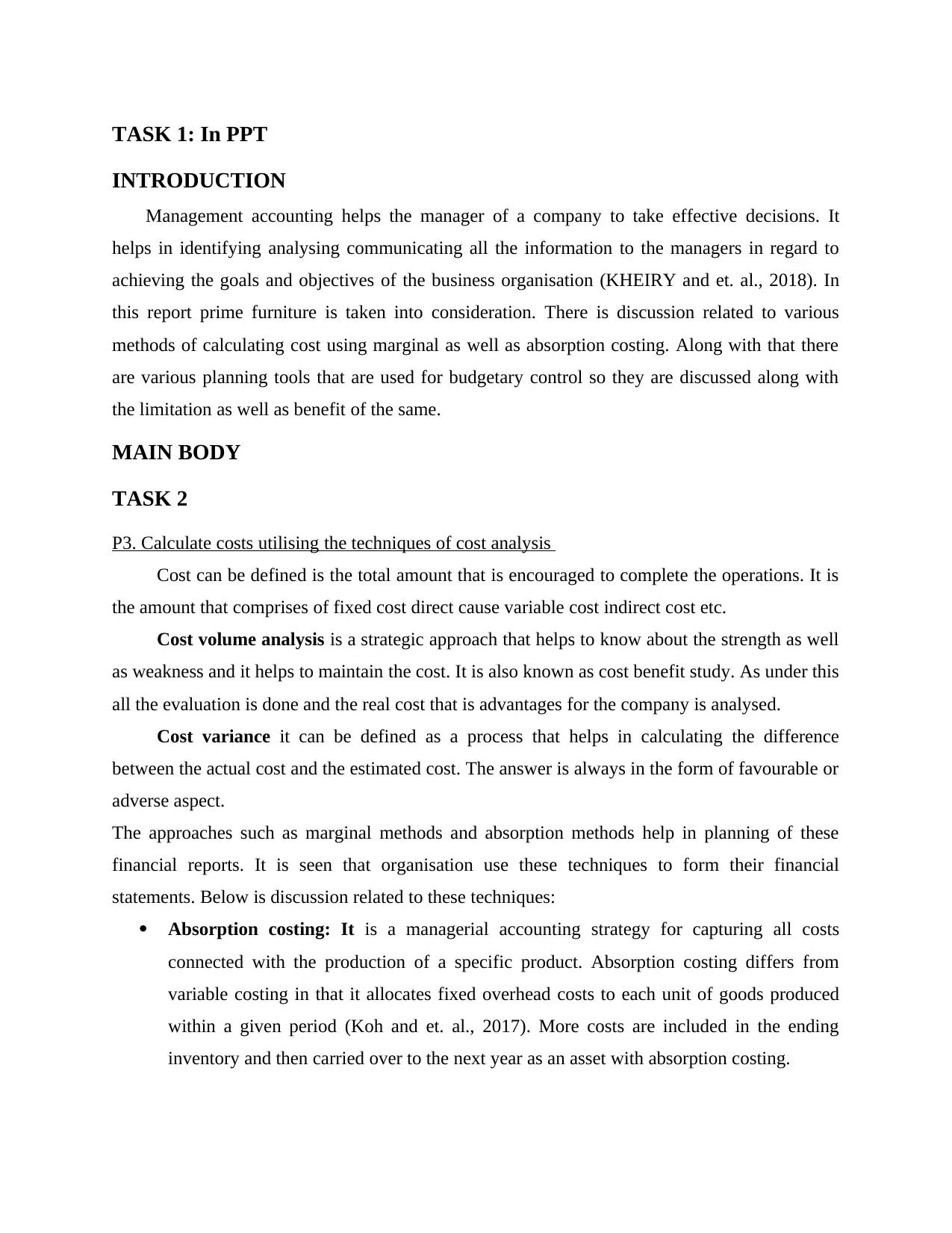
TASK 1: In PPT
INTRODUCTION
Management accounting helps the manager of a company to take effective decisions. It
helps in identifying analysing communicating all the information to the managers in regard to
achieving the goals and objectives of the business organisation (KHEIRY and et. al., 2018). In
this report prime furniture is taken into consideration. There is discussion related to various
methods of calculating cost using marginal as well as absorption costing. Along with that there
are various planning tools that are used for budgetary control so they are discussed along with
the limitation as well as benefit of the same.
MAIN BODY
TASK 2
P3. Calculate costs utilising the techniques of cost analysis
Cost can be defined is the total amount that is encouraged to complete the operations. It is
the amount that comprises of fixed cost direct cause variable cost indirect cost etc.
Cost volume analysis is a strategic approach that helps to know about the strength as well
as weakness and it helps to maintain the cost. It is also known as cost benefit study. As under this
all the evaluation is done and the real cost that is advantages for the company is analysed.
Cost variance it can be defined as a process that helps in calculating the difference
between the actual cost and the estimated cost. The answer is always in the form of favourable or
adverse aspect.
The approaches such as marginal methods and absorption methods help in planning of these
financial reports. It is seen that organisation use these techniques to form their financial
statements. Below is discussion related to these techniques:
Absorption costing: It is a managerial accounting strategy for capturing all costs
connected with the production of a specific product. Absorption costing differs from
variable costing in that it allocates fixed overhead costs to each unit of goods produced
within a given period (Koh and et. al., 2017). More costs are included in the ending
inventory and then carried over to the next year as an asset with absorption costing.
INTRODUCTION
Management accounting helps the manager of a company to take effective decisions. It
helps in identifying analysing communicating all the information to the managers in regard to
achieving the goals and objectives of the business organisation (KHEIRY and et. al., 2018). In
this report prime furniture is taken into consideration. There is discussion related to various
methods of calculating cost using marginal as well as absorption costing. Along with that there
are various planning tools that are used for budgetary control so they are discussed along with
the limitation as well as benefit of the same.
MAIN BODY
TASK 2
P3. Calculate costs utilising the techniques of cost analysis
Cost can be defined is the total amount that is encouraged to complete the operations. It is
the amount that comprises of fixed cost direct cause variable cost indirect cost etc.
Cost volume analysis is a strategic approach that helps to know about the strength as well
as weakness and it helps to maintain the cost. It is also known as cost benefit study. As under this
all the evaluation is done and the real cost that is advantages for the company is analysed.
Cost variance it can be defined as a process that helps in calculating the difference
between the actual cost and the estimated cost. The answer is always in the form of favourable or
adverse aspect.
The approaches such as marginal methods and absorption methods help in planning of these
financial reports. It is seen that organisation use these techniques to form their financial
statements. Below is discussion related to these techniques:
Absorption costing: It is a managerial accounting strategy for capturing all costs
connected with the production of a specific product. Absorption costing differs from
variable costing in that it allocates fixed overhead costs to each unit of goods produced
within a given period (Koh and et. al., 2017). More costs are included in the ending
inventory and then carried over to the next year as an asset with absorption costing.
⊘ This is a preview!⊘
Do you want full access?
Subscribe today to unlock all pages.

Trusted by 1+ million students worldwide
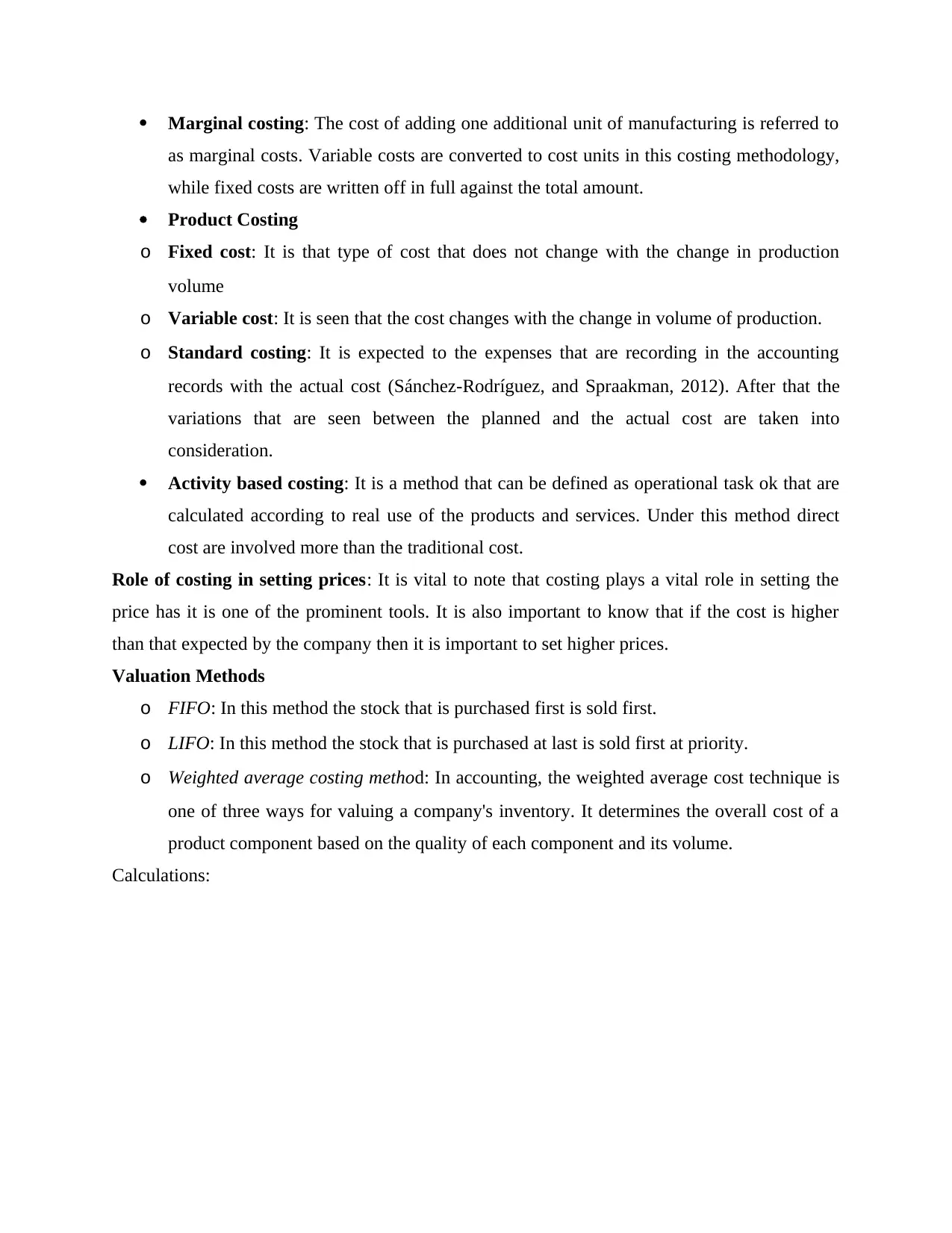
Marginal costing: The cost of adding one additional unit of manufacturing is referred to
as marginal costs. Variable costs are converted to cost units in this costing methodology,
while fixed costs are written off in full against the total amount.
Product Costing
o Fixed cost: It is that type of cost that does not change with the change in production
volume
o Variable cost: It is seen that the cost changes with the change in volume of production.
o Standard costing: It is expected to the expenses that are recording in the accounting
records with the actual cost (Sánchez-Rodríguez, and Spraakman, 2012). After that the
variations that are seen between the planned and the actual cost are taken into
consideration.
Activity based costing: It is a method that can be defined as operational task ok that are
calculated according to real use of the products and services. Under this method direct
cost are involved more than the traditional cost.
Role of costing in setting prices: It is vital to note that costing plays a vital role in setting the
price has it is one of the prominent tools. It is also important to know that if the cost is higher
than that expected by the company then it is important to set higher prices.
Valuation Methods
o FIFO: In this method the stock that is purchased first is sold first.
o LIFO: In this method the stock that is purchased at last is sold first at priority.
o Weighted average costing method: In accounting, the weighted average cost technique is
one of three ways for valuing a company's inventory. It determines the overall cost of a
product component based on the quality of each component and its volume.
Calculations:
as marginal costs. Variable costs are converted to cost units in this costing methodology,
while fixed costs are written off in full against the total amount.
Product Costing
o Fixed cost: It is that type of cost that does not change with the change in production
volume
o Variable cost: It is seen that the cost changes with the change in volume of production.
o Standard costing: It is expected to the expenses that are recording in the accounting
records with the actual cost (Sánchez-Rodríguez, and Spraakman, 2012). After that the
variations that are seen between the planned and the actual cost are taken into
consideration.
Activity based costing: It is a method that can be defined as operational task ok that are
calculated according to real use of the products and services. Under this method direct
cost are involved more than the traditional cost.
Role of costing in setting prices: It is vital to note that costing plays a vital role in setting the
price has it is one of the prominent tools. It is also important to know that if the cost is higher
than that expected by the company then it is important to set higher prices.
Valuation Methods
o FIFO: In this method the stock that is purchased first is sold first.
o LIFO: In this method the stock that is purchased at last is sold first at priority.
o Weighted average costing method: In accounting, the weighted average cost technique is
one of three ways for valuing a company's inventory. It determines the overall cost of a
product component based on the quality of each component and its volume.
Calculations:
Paraphrase This Document
Need a fresh take? Get an instant paraphrase of this document with our AI Paraphraser
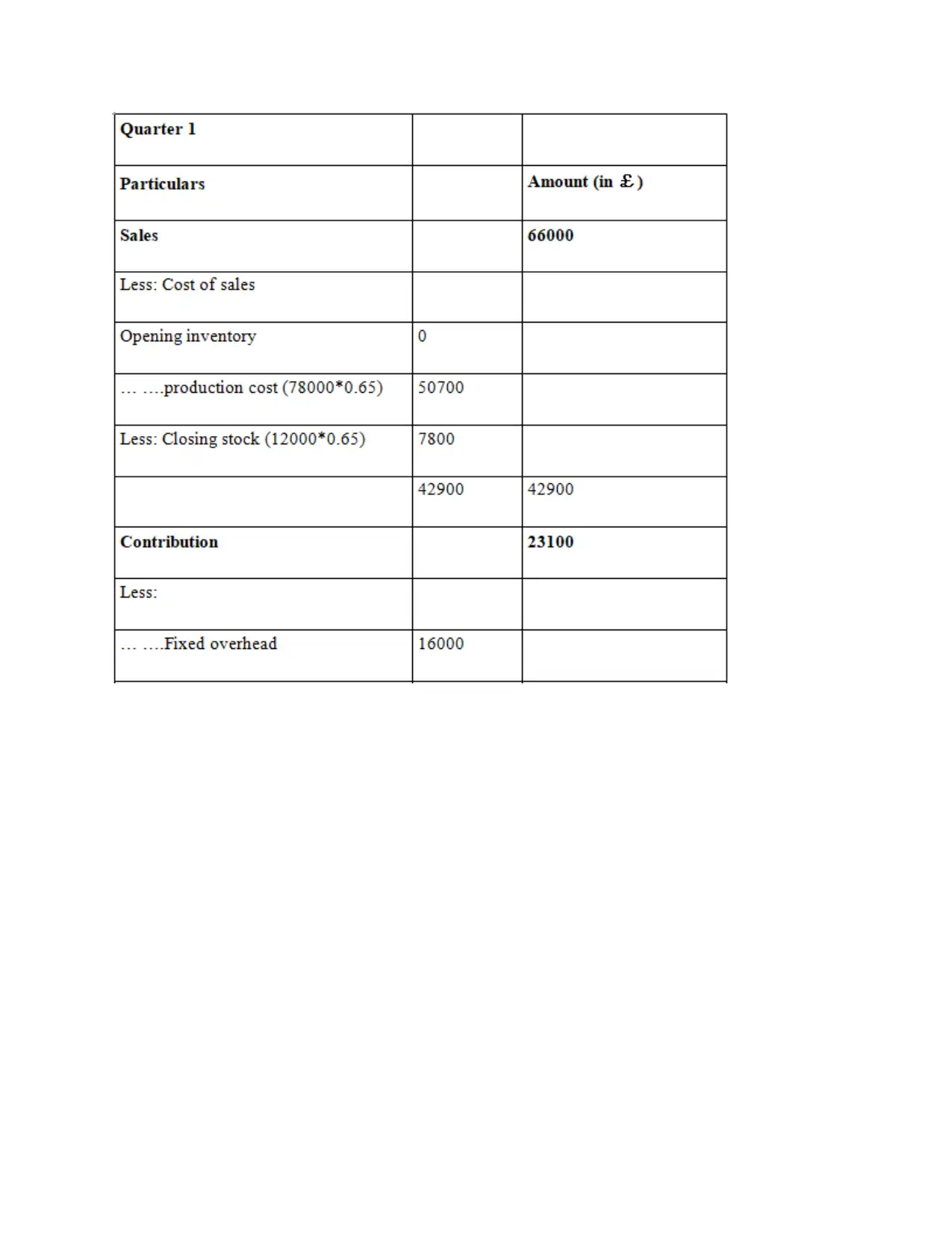
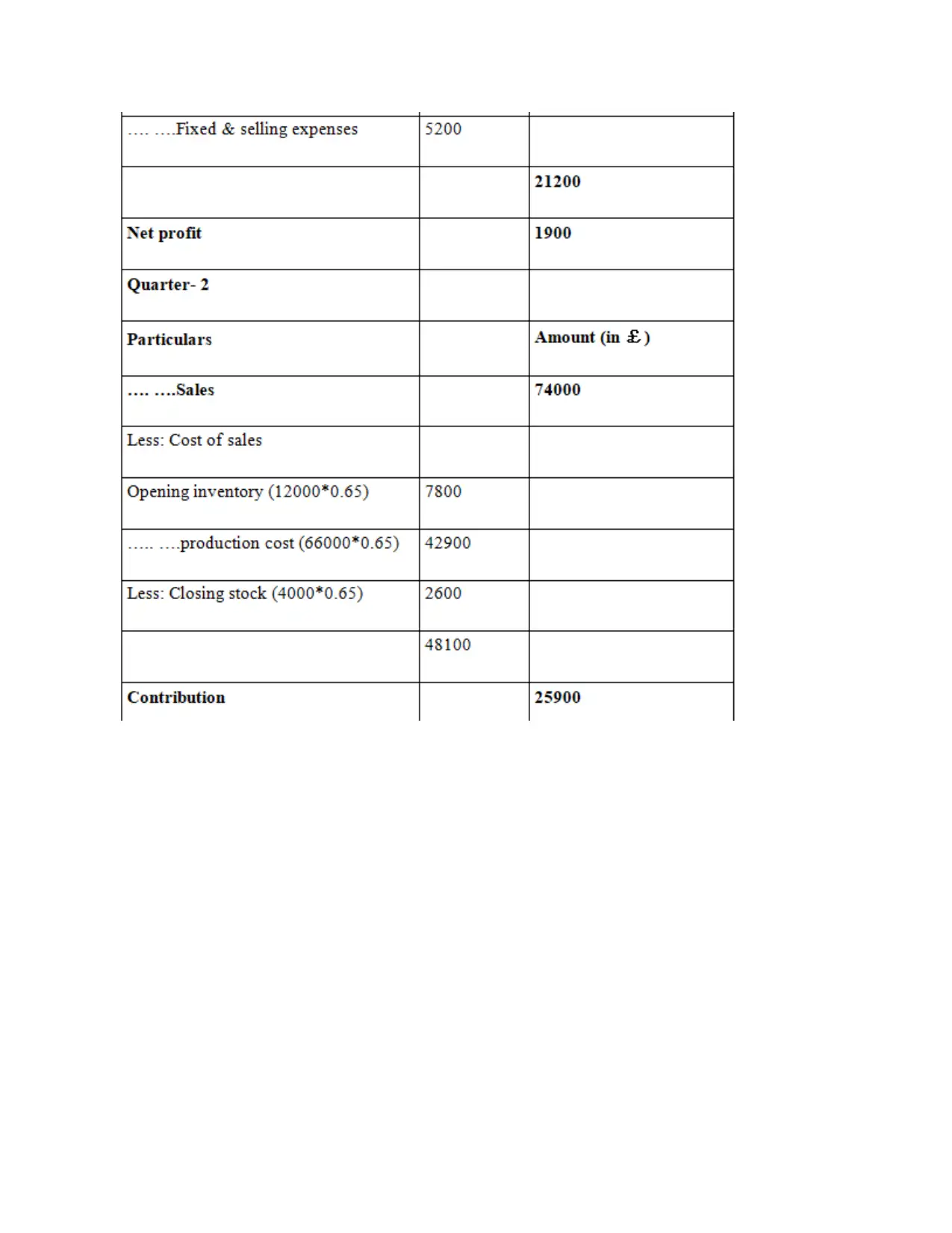
⊘ This is a preview!⊘
Do you want full access?
Subscribe today to unlock all pages.

Trusted by 1+ million students worldwide
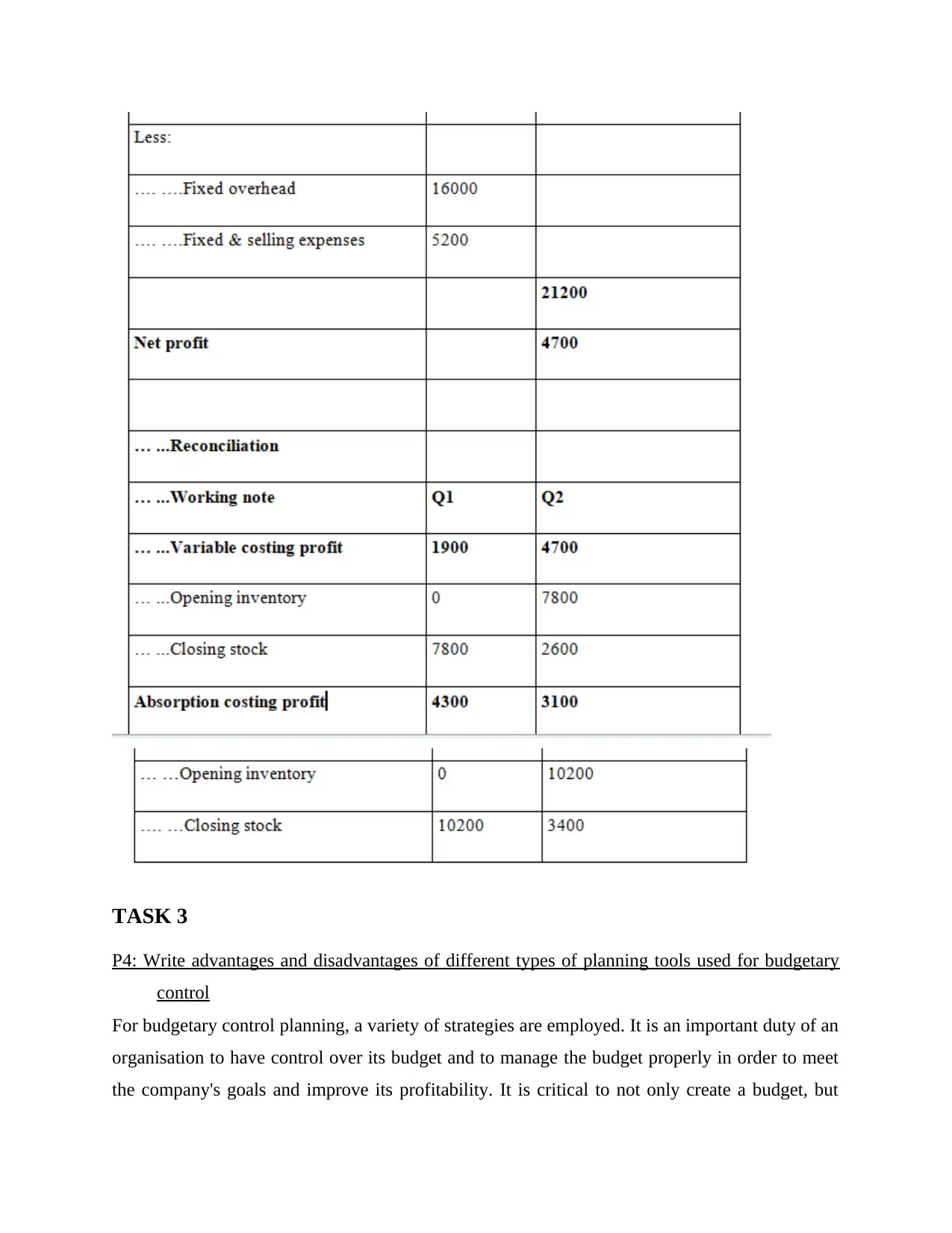
TASK 3
P4: Write advantages and disadvantages of different types of planning tools used for budgetary
control
For budgetary control planning, a variety of strategies are employed. It is an important duty of an
organisation to have control over its budget and to manage the budget properly in order to meet
the company's goals and improve its profitability. It is critical to not only create a budget, but
P4: Write advantages and disadvantages of different types of planning tools used for budgetary
control
For budgetary control planning, a variety of strategies are employed. It is an important duty of an
organisation to have control over its budget and to manage the budget properly in order to meet
the company's goals and improve its profitability. It is critical to not only create a budget, but
Paraphrase This Document
Need a fresh take? Get an instant paraphrase of this document with our AI Paraphraser
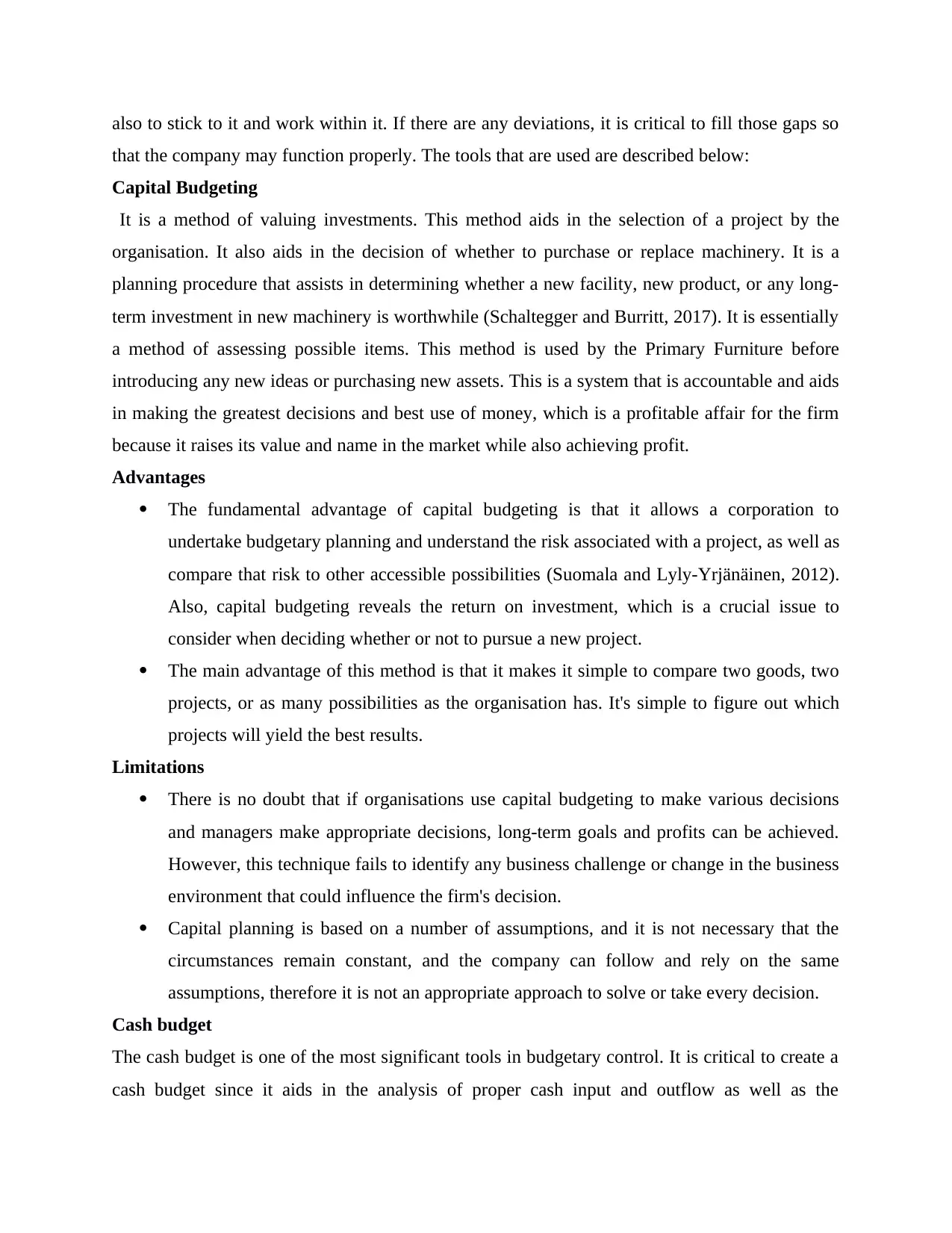
also to stick to it and work within it. If there are any deviations, it is critical to fill those gaps so
that the company may function properly. The tools that are used are described below:
Capital Budgeting
It is a method of valuing investments. This method aids in the selection of a project by the
organisation. It also aids in the decision of whether to purchase or replace machinery. It is a
planning procedure that assists in determining whether a new facility, new product, or any long-
term investment in new machinery is worthwhile (Schaltegger and Burritt, 2017). It is essentially
a method of assessing possible items. This method is used by the Primary Furniture before
introducing any new ideas or purchasing new assets. This is a system that is accountable and aids
in making the greatest decisions and best use of money, which is a profitable affair for the firm
because it raises its value and name in the market while also achieving profit.
Advantages
The fundamental advantage of capital budgeting is that it allows a corporation to
undertake budgetary planning and understand the risk associated with a project, as well as
compare that risk to other accessible possibilities (Suomala and Lyly-Yrjänäinen, 2012).
Also, capital budgeting reveals the return on investment, which is a crucial issue to
consider when deciding whether or not to pursue a new project.
The main advantage of this method is that it makes it simple to compare two goods, two
projects, or as many possibilities as the organisation has. It's simple to figure out which
projects will yield the best results.
Limitations
There is no doubt that if organisations use capital budgeting to make various decisions
and managers make appropriate decisions, long-term goals and profits can be achieved.
However, this technique fails to identify any business challenge or change in the business
environment that could influence the firm's decision.
Capital planning is based on a number of assumptions, and it is not necessary that the
circumstances remain constant, and the company can follow and rely on the same
assumptions, therefore it is not an appropriate approach to solve or take every decision.
Cash budget
The cash budget is one of the most significant tools in budgetary control. It is critical to create a
cash budget since it aids in the analysis of proper cash input and outflow as well as the
that the company may function properly. The tools that are used are described below:
Capital Budgeting
It is a method of valuing investments. This method aids in the selection of a project by the
organisation. It also aids in the decision of whether to purchase or replace machinery. It is a
planning procedure that assists in determining whether a new facility, new product, or any long-
term investment in new machinery is worthwhile (Schaltegger and Burritt, 2017). It is essentially
a method of assessing possible items. This method is used by the Primary Furniture before
introducing any new ideas or purchasing new assets. This is a system that is accountable and aids
in making the greatest decisions and best use of money, which is a profitable affair for the firm
because it raises its value and name in the market while also achieving profit.
Advantages
The fundamental advantage of capital budgeting is that it allows a corporation to
undertake budgetary planning and understand the risk associated with a project, as well as
compare that risk to other accessible possibilities (Suomala and Lyly-Yrjänäinen, 2012).
Also, capital budgeting reveals the return on investment, which is a crucial issue to
consider when deciding whether or not to pursue a new project.
The main advantage of this method is that it makes it simple to compare two goods, two
projects, or as many possibilities as the organisation has. It's simple to figure out which
projects will yield the best results.
Limitations
There is no doubt that if organisations use capital budgeting to make various decisions
and managers make appropriate decisions, long-term goals and profits can be achieved.
However, this technique fails to identify any business challenge or change in the business
environment that could influence the firm's decision.
Capital planning is based on a number of assumptions, and it is not necessary that the
circumstances remain constant, and the company can follow and rely on the same
assumptions, therefore it is not an appropriate approach to solve or take every decision.
Cash budget
The cash budget is one of the most significant tools in budgetary control. It is critical to create a
cash budget since it aids in the analysis of proper cash input and outflow as well as the
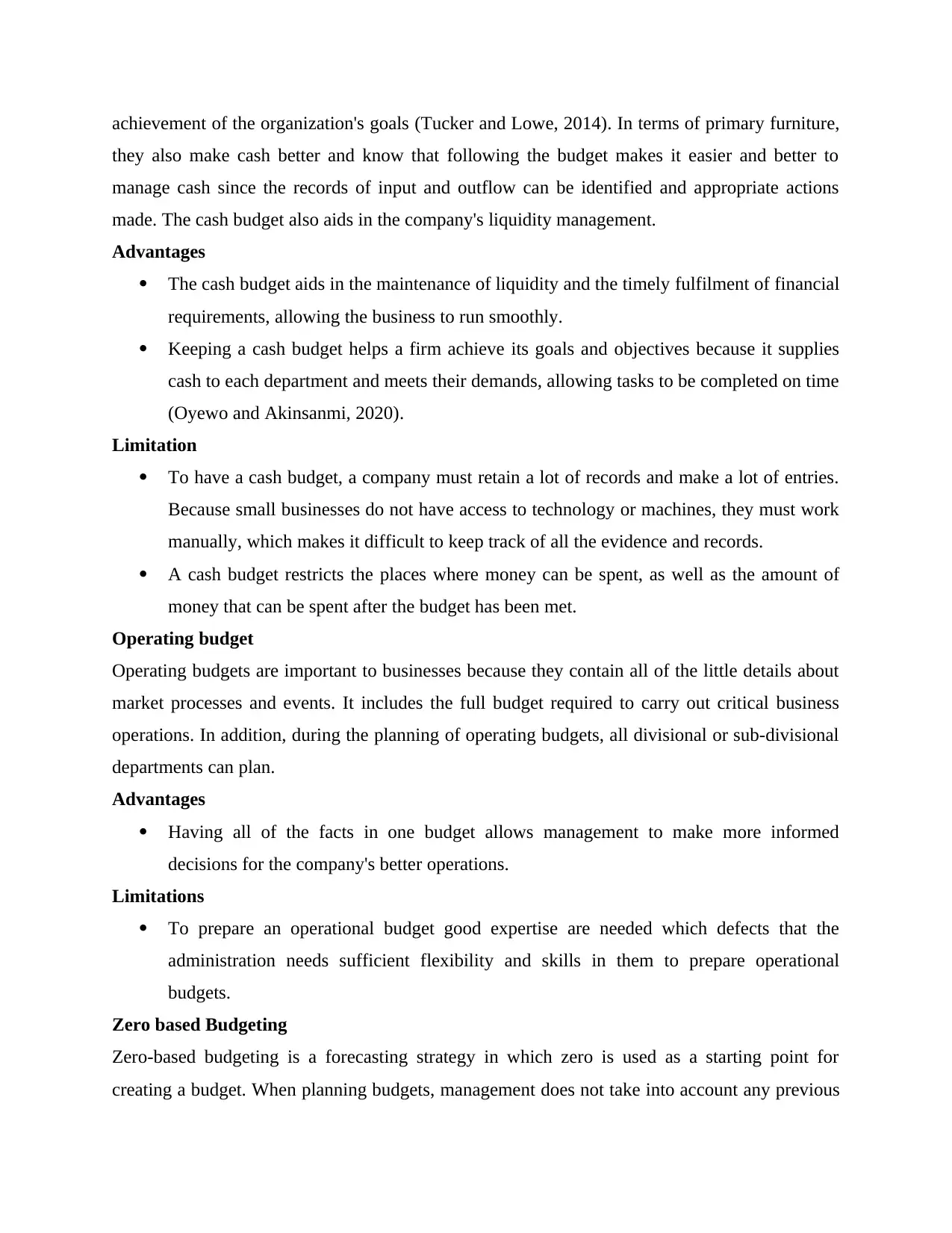
achievement of the organization's goals (Tucker and Lowe, 2014). In terms of primary furniture,
they also make cash better and know that following the budget makes it easier and better to
manage cash since the records of input and outflow can be identified and appropriate actions
made. The cash budget also aids in the company's liquidity management.
Advantages
The cash budget aids in the maintenance of liquidity and the timely fulfilment of financial
requirements, allowing the business to run smoothly.
Keeping a cash budget helps a firm achieve its goals and objectives because it supplies
cash to each department and meets their demands, allowing tasks to be completed on time
(Oyewo and Akinsanmi, 2020).
Limitation
To have a cash budget, a company must retain a lot of records and make a lot of entries.
Because small businesses do not have access to technology or machines, they must work
manually, which makes it difficult to keep track of all the evidence and records.
A cash budget restricts the places where money can be spent, as well as the amount of
money that can be spent after the budget has been met.
Operating budget
Operating budgets are important to businesses because they contain all of the little details about
market processes and events. It includes the full budget required to carry out critical business
operations. In addition, during the planning of operating budgets, all divisional or sub-divisional
departments can plan.
Advantages
Having all of the facts in one budget allows management to make more informed
decisions for the company's better operations.
Limitations
To prepare an operational budget good expertise are needed which defects that the
administration needs sufficient flexibility and skills in them to prepare operational
budgets.
Zero based Budgeting
Zero-based budgeting is a forecasting strategy in which zero is used as a starting point for
creating a budget. When planning budgets, management does not take into account any previous
they also make cash better and know that following the budget makes it easier and better to
manage cash since the records of input and outflow can be identified and appropriate actions
made. The cash budget also aids in the company's liquidity management.
Advantages
The cash budget aids in the maintenance of liquidity and the timely fulfilment of financial
requirements, allowing the business to run smoothly.
Keeping a cash budget helps a firm achieve its goals and objectives because it supplies
cash to each department and meets their demands, allowing tasks to be completed on time
(Oyewo and Akinsanmi, 2020).
Limitation
To have a cash budget, a company must retain a lot of records and make a lot of entries.
Because small businesses do not have access to technology or machines, they must work
manually, which makes it difficult to keep track of all the evidence and records.
A cash budget restricts the places where money can be spent, as well as the amount of
money that can be spent after the budget has been met.
Operating budget
Operating budgets are important to businesses because they contain all of the little details about
market processes and events. It includes the full budget required to carry out critical business
operations. In addition, during the planning of operating budgets, all divisional or sub-divisional
departments can plan.
Advantages
Having all of the facts in one budget allows management to make more informed
decisions for the company's better operations.
Limitations
To prepare an operational budget good expertise are needed which defects that the
administration needs sufficient flexibility and skills in them to prepare operational
budgets.
Zero based Budgeting
Zero-based budgeting is a forecasting strategy in which zero is used as a starting point for
creating a budget. When planning budgets, management does not take into account any previous
⊘ This is a preview!⊘
Do you want full access?
Subscribe today to unlock all pages.

Trusted by 1+ million students worldwide
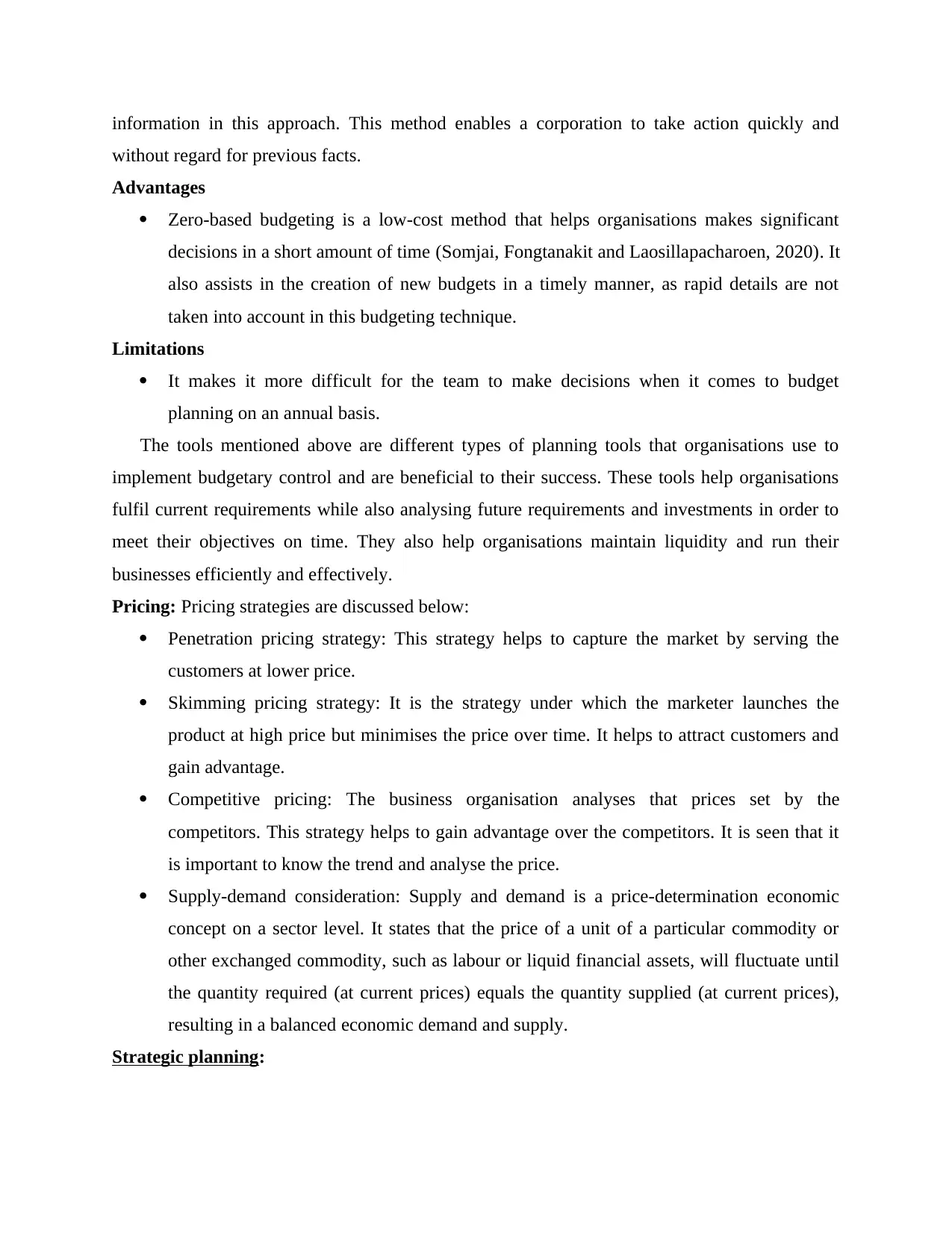
information in this approach. This method enables a corporation to take action quickly and
without regard for previous facts.
Advantages
Zero-based budgeting is a low-cost method that helps organisations makes significant
decisions in a short amount of time (Somjai, Fongtanakit and Laosillapacharoen, 2020). It
also assists in the creation of new budgets in a timely manner, as rapid details are not
taken into account in this budgeting technique.
Limitations
It makes it more difficult for the team to make decisions when it comes to budget
planning on an annual basis.
The tools mentioned above are different types of planning tools that organisations use to
implement budgetary control and are beneficial to their success. These tools help organisations
fulfil current requirements while also analysing future requirements and investments in order to
meet their objectives on time. They also help organisations maintain liquidity and run their
businesses efficiently and effectively.
Pricing: Pricing strategies are discussed below:
Penetration pricing strategy: This strategy helps to capture the market by serving the
customers at lower price.
Skimming pricing strategy: It is the strategy under which the marketer launches the
product at high price but minimises the price over time. It helps to attract customers and
gain advantage.
Competitive pricing: The business organisation analyses that prices set by the
competitors. This strategy helps to gain advantage over the competitors. It is seen that it
is important to know the trend and analyse the price.
Supply-demand consideration: Supply and demand is a price-determination economic
concept on a sector level. It states that the price of a unit of a particular commodity or
other exchanged commodity, such as labour or liquid financial assets, will fluctuate until
the quantity required (at current prices) equals the quantity supplied (at current prices),
resulting in a balanced economic demand and supply.
Strategic planning:
without regard for previous facts.
Advantages
Zero-based budgeting is a low-cost method that helps organisations makes significant
decisions in a short amount of time (Somjai, Fongtanakit and Laosillapacharoen, 2020). It
also assists in the creation of new budgets in a timely manner, as rapid details are not
taken into account in this budgeting technique.
Limitations
It makes it more difficult for the team to make decisions when it comes to budget
planning on an annual basis.
The tools mentioned above are different types of planning tools that organisations use to
implement budgetary control and are beneficial to their success. These tools help organisations
fulfil current requirements while also analysing future requirements and investments in order to
meet their objectives on time. They also help organisations maintain liquidity and run their
businesses efficiently and effectively.
Pricing: Pricing strategies are discussed below:
Penetration pricing strategy: This strategy helps to capture the market by serving the
customers at lower price.
Skimming pricing strategy: It is the strategy under which the marketer launches the
product at high price but minimises the price over time. It helps to attract customers and
gain advantage.
Competitive pricing: The business organisation analyses that prices set by the
competitors. This strategy helps to gain advantage over the competitors. It is seen that it
is important to know the trend and analyse the price.
Supply-demand consideration: Supply and demand is a price-determination economic
concept on a sector level. It states that the price of a unit of a particular commodity or
other exchanged commodity, such as labour or liquid financial assets, will fluctuate until
the quantity required (at current prices) equals the quantity supplied (at current prices),
resulting in a balanced economic demand and supply.
Strategic planning:
Paraphrase This Document
Need a fresh take? Get an instant paraphrase of this document with our AI Paraphraser
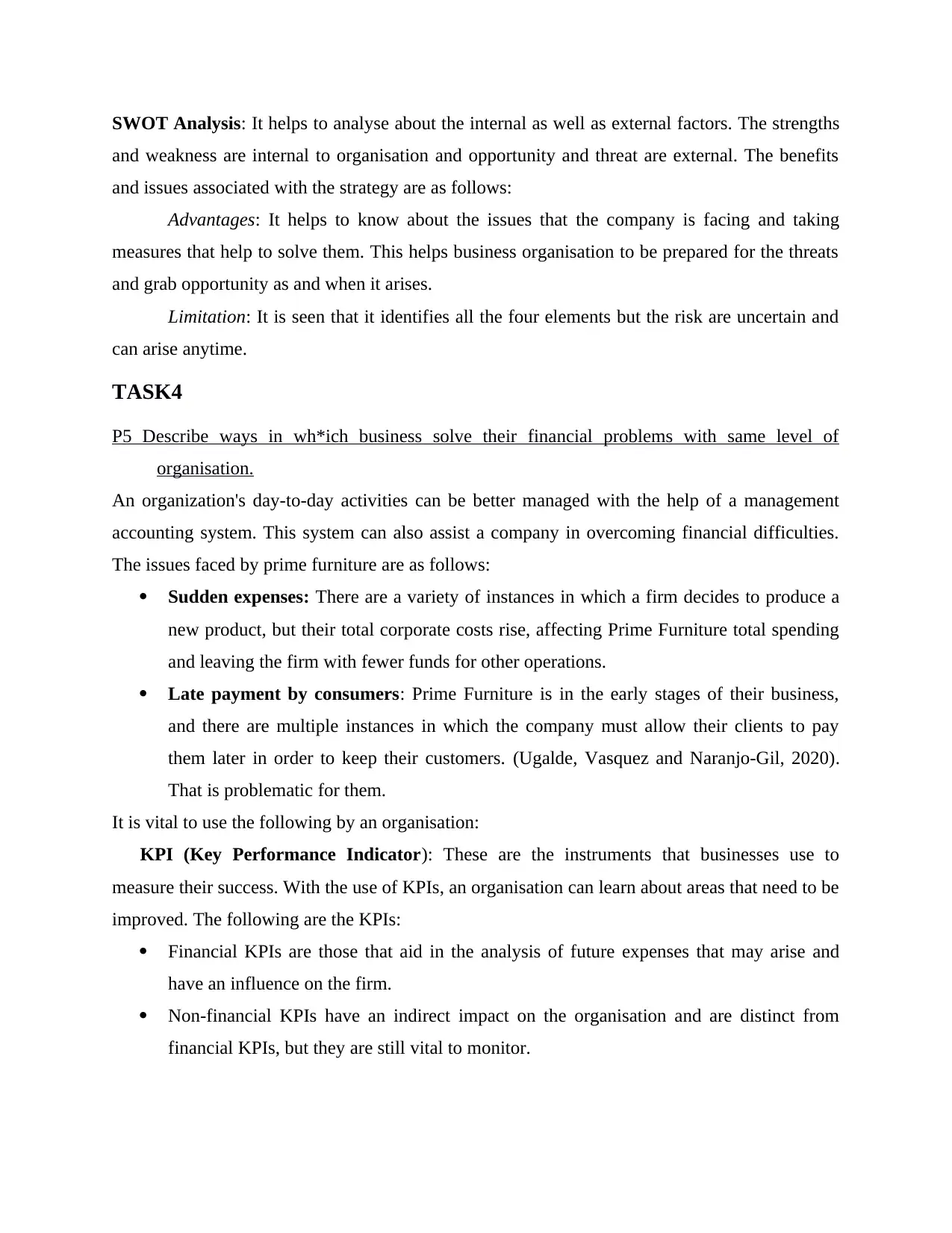
SWOT Analysis: It helps to analyse about the internal as well as external factors. The strengths
and weakness are internal to organisation and opportunity and threat are external. The benefits
and issues associated with the strategy are as follows:
Advantages: It helps to know about the issues that the company is facing and taking
measures that help to solve them. This helps business organisation to be prepared for the threats
and grab opportunity as and when it arises.
Limitation: It is seen that it identifies all the four elements but the risk are uncertain and
can arise anytime.
TASK4
P5 Describe ways in wh*ich business solve their financial problems with same level of
organisation.
An organization's day-to-day activities can be better managed with the help of a management
accounting system. This system can also assist a company in overcoming financial difficulties.
The issues faced by prime furniture are as follows:
Sudden expenses: There are a variety of instances in which a firm decides to produce a
new product, but their total corporate costs rise, affecting Prime Furniture total spending
and leaving the firm with fewer funds for other operations.
Late payment by consumers: Prime Furniture is in the early stages of their business,
and there are multiple instances in which the company must allow their clients to pay
them later in order to keep their customers. (Ugalde, Vasquez and Naranjo-Gil, 2020).
That is problematic for them.
It is vital to use the following by an organisation:
KPI (Key Performance Indicator): These are the instruments that businesses use to
measure their success. With the use of KPIs, an organisation can learn about areas that need to be
improved. The following are the KPIs:
Financial KPIs are those that aid in the analysis of future expenses that may arise and
have an influence on the firm.
Non-financial KPIs have an indirect impact on the organisation and are distinct from
financial KPIs, but they are still vital to monitor.
and weakness are internal to organisation and opportunity and threat are external. The benefits
and issues associated with the strategy are as follows:
Advantages: It helps to know about the issues that the company is facing and taking
measures that help to solve them. This helps business organisation to be prepared for the threats
and grab opportunity as and when it arises.
Limitation: It is seen that it identifies all the four elements but the risk are uncertain and
can arise anytime.
TASK4
P5 Describe ways in wh*ich business solve their financial problems with same level of
organisation.
An organization's day-to-day activities can be better managed with the help of a management
accounting system. This system can also assist a company in overcoming financial difficulties.
The issues faced by prime furniture are as follows:
Sudden expenses: There are a variety of instances in which a firm decides to produce a
new product, but their total corporate costs rise, affecting Prime Furniture total spending
and leaving the firm with fewer funds for other operations.
Late payment by consumers: Prime Furniture is in the early stages of their business,
and there are multiple instances in which the company must allow their clients to pay
them later in order to keep their customers. (Ugalde, Vasquez and Naranjo-Gil, 2020).
That is problematic for them.
It is vital to use the following by an organisation:
KPI (Key Performance Indicator): These are the instruments that businesses use to
measure their success. With the use of KPIs, an organisation can learn about areas that need to be
improved. The following are the KPIs:
Financial KPIs are those that aid in the analysis of future expenses that may arise and
have an influence on the firm.
Non-financial KPIs have an indirect impact on the organisation and are distinct from
financial KPIs, but they are still vital to monitor.
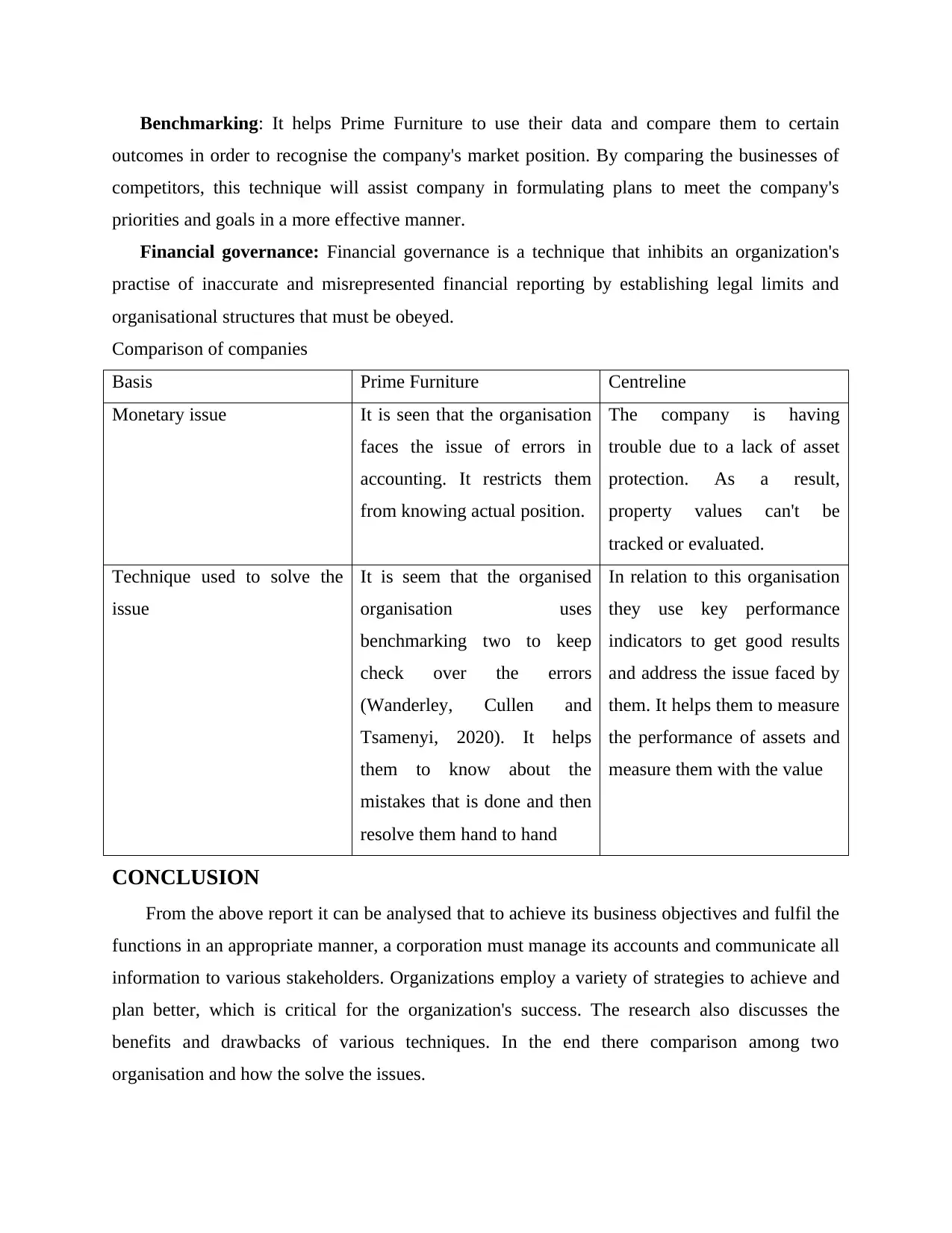
Benchmarking: It helps Prime Furniture to use their data and compare them to certain
outcomes in order to recognise the company's market position. By comparing the businesses of
competitors, this technique will assist company in formulating plans to meet the company's
priorities and goals in a more effective manner.
Financial governance: Financial governance is a technique that inhibits an organization's
practise of inaccurate and misrepresented financial reporting by establishing legal limits and
organisational structures that must be obeyed.
Comparison of companies
Basis Prime Furniture Centreline
Monetary issue It is seen that the organisation
faces the issue of errors in
accounting. It restricts them
from knowing actual position.
The company is having
trouble due to a lack of asset
protection. As a result,
property values can't be
tracked or evaluated.
Technique used to solve the
issue
It is seem that the organised
organisation uses
benchmarking two to keep
check over the errors
(Wanderley, Cullen and
Tsamenyi, 2020). It helps
them to know about the
mistakes that is done and then
resolve them hand to hand
In relation to this organisation
they use key performance
indicators to get good results
and address the issue faced by
them. It helps them to measure
the performance of assets and
measure them with the value
CONCLUSION
From the above report it can be analysed that to achieve its business objectives and fulfil the
functions in an appropriate manner, a corporation must manage its accounts and communicate all
information to various stakeholders. Organizations employ a variety of strategies to achieve and
plan better, which is critical for the organization's success. The research also discusses the
benefits and drawbacks of various techniques. In the end there comparison among two
organisation and how the solve the issues.
outcomes in order to recognise the company's market position. By comparing the businesses of
competitors, this technique will assist company in formulating plans to meet the company's
priorities and goals in a more effective manner.
Financial governance: Financial governance is a technique that inhibits an organization's
practise of inaccurate and misrepresented financial reporting by establishing legal limits and
organisational structures that must be obeyed.
Comparison of companies
Basis Prime Furniture Centreline
Monetary issue It is seen that the organisation
faces the issue of errors in
accounting. It restricts them
from knowing actual position.
The company is having
trouble due to a lack of asset
protection. As a result,
property values can't be
tracked or evaluated.
Technique used to solve the
issue
It is seem that the organised
organisation uses
benchmarking two to keep
check over the errors
(Wanderley, Cullen and
Tsamenyi, 2020). It helps
them to know about the
mistakes that is done and then
resolve them hand to hand
In relation to this organisation
they use key performance
indicators to get good results
and address the issue faced by
them. It helps them to measure
the performance of assets and
measure them with the value
CONCLUSION
From the above report it can be analysed that to achieve its business objectives and fulfil the
functions in an appropriate manner, a corporation must manage its accounts and communicate all
information to various stakeholders. Organizations employ a variety of strategies to achieve and
plan better, which is critical for the organization's success. The research also discusses the
benefits and drawbacks of various techniques. In the end there comparison among two
organisation and how the solve the issues.
⊘ This is a preview!⊘
Do you want full access?
Subscribe today to unlock all pages.

Trusted by 1+ million students worldwide
1 out of 13
Related Documents
Your All-in-One AI-Powered Toolkit for Academic Success.
+13062052269
info@desklib.com
Available 24*7 on WhatsApp / Email
![[object Object]](/_next/static/media/star-bottom.7253800d.svg)
Unlock your academic potential
Copyright © 2020–2025 A2Z Services. All Rights Reserved. Developed and managed by ZUCOL.




